![]() Capos with elastic straps
Capos with elastic straps
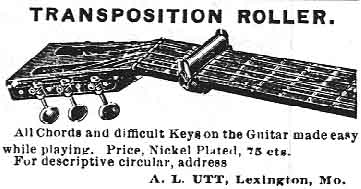 |
Capo ad from the late 1890's. [Source: Mugwumps] |
| . | |
| Transposition Roller US patent in 1897 by Lincoln Utt. |
|
| The bar is a rubber roll with a "yielding or flexible core or spindle". This indicates that curved fretboards were in use at the time. Tension is created by a coil spring. Between the back of the neck and the spring is a thin metal plate, either for neck protection or easier sliding. The spring is held in place by outward bent ears on the plate. You can see the slotted ends of the plate on each side of the roll. | |
Coil Spring Capos |
| Capos of this type have a coil spring around the neck. They were marketed as banjo/ukulele capos. The spring force was probably not sufficient for more than four strings. To protect the finish of the instrument neck, the users often put some tubing around the spring. |
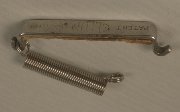 |
Elton Cork pad. Made by Elton. |
 |
Moment A similar capo was made by Moment. Cork pad missing. |
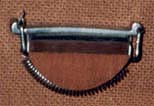 |
The Garnac The spring is fastened to square metal loops. You can see the remains of a handle on the left side of the bar. [Owner: Pete Stanley, London] |
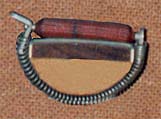 |
Keech This is probably a development from the original patent. This capo has a rubber rolling bar. The L-shaped handle has an inverted key-hole that fits the end of the bar. Made by Keech. [Owner: Pete Stanley, London] |
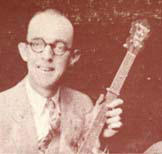 |
Jimmie Rodgers using a capo of
this type. Picture taken in May 1927. |
|
Elton copy made by Arkansas Red. |
| If you look at any of the old Pete Seeger albums or Kingston Trio albums the Elton capos they are using have the "red hot water bottle tubing" on them. This is more tradition than anything else. All the 60's long neck banjo folkies used the red hot water bottle tubing. The tiny "ribs" on the tubing make the capo slide up and down the neck without any jerky hangups. Nick Reynolds, who played tenor guitar with the Kingston Trio said he had used surgical latex tubing, but it didn't last, so one day he cut a piece from his mother's enema bag tubing and it worked so well he kept using it. Pete Seeger, in his book How To Play The Five String Banjo, says to use shower hose tubing, but when questioned about it, he said that was a misprint, and that "hot water bottle tubing" was what he meant to say. |
| Elastics US patent 1931 by William H Russell. |
| I think that this is the greatest capo invention. Almost every capo user has had one. |
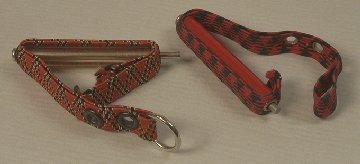 |
Standard elastic capos with eyelets. |
|
Put the elastic banjo capo around the strings between |
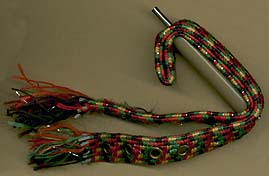 |
Elastic capo with heavy double straps. The straps used to have metal fittings at the ends to prevent them from looking like this. |
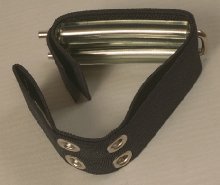 |
Maxtone® This one
has double bars. |
| Here is another one. |
Here is an interesting line of development - from string to lever:
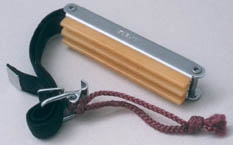 |
Instead of eyelets this capo has a buckle with a hook and a string handle.
The original elastic had the same color as the string. Oversized metal bar with a large
grooved rubber pad. This capo is shown from another point of view above the menu. Made in Japan. |
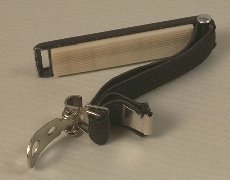 |
Buckle with hook and metal handle. Tin bar. There are tiny grooves along the pad. |
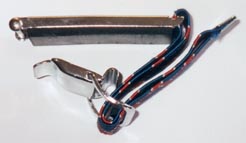 |
Here the hook and handle has developed into a lever. When the hook is
attached to the end of the bar, the handle is flipped over to the top of the bar to get
extra tension. [Owner: Philippe Saint-Pierre, France.] |
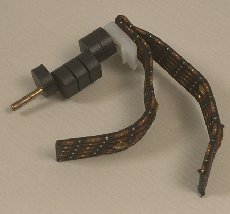 |
Third Hand US patent 1980 by Lyle F Shabram, Jr. This is a special capo with turnable rubber disks
for fretting individual strings. Next to the strap is a nylon support for
balancing the capo when few discs are used. Using one or more capos you can form chords, thus emulating
open tunings without retuning the guitar. This is called partial capoing. Scales
and closed chords are not altered. Check it out on Third Hand Capo. |
| Glider US patent 1986 by Swany D Cornette. Designed for quick key changes. Both the bar and the neck protection are rubber rolls. Some info on Glider. |
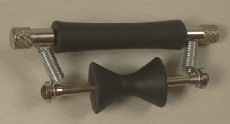 |
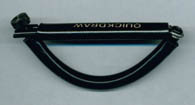 |
Quick Draw US patent 1991 by Jay S Kaufman. This is a development of the coil spring capo for quick key changes. Instead of rolls, the tubing around the bar and coil spring, is made of low friction material. The bar is springy to adjust to fretboards with different radii. The adjustment screw is threaded into the coil spring. |
| . |
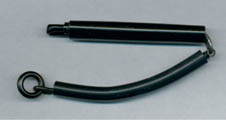 |
The Quick Draw was upgraded in 2000. The head of the adjustment screw is
changed to a ring that slips over the end of the bar. The coil spring is now hinged to the
bar. Manufactured by Kaufman Music Accessories. [Donated by Steve Kaufman] |
Brittish patent 2001 by Martin Thorne & Martin Furey. A chord forming capo for partial capoing. Made of brass. The ends of the fingers are
flattened on to which is pushed slotted rubber blocks. The fingers are locked by the small
screws on top of the bar. The ends of the bar are spring loaded. When attaching the capo
you first pull the ends apart and clamp the capo to the sides of the fretboard, then you
tighten it with the moulded rubber strap. |